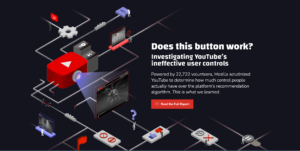Report: “YouTube’s ‘Dislike’ Button Doesn’t Do What You Think”
From WIRED:
YouTube Creators Often implore their viewers to ‘smash that Like button,’ believing its feedback to be vital to their future success on the algorithm-driven platform. But a new study from the Mozilla Foundation suggests that users who hit the Dislike button on videos to weed out content they don’t want to see are wasting their time.
The study used inputs from 22,722 users who had installed Mozilla’s RegretsReporter browser extension, who were tracked between December 2021 and June 2022. Researchers analyzed more than half a billion YouTube recommendations that were made after users clicked on one of YouTube’s negative feedback tools, such as the Dislike or Don’t Recommend Channel buttons. “These are the tools YouTube offers for people to control their recommendations, but how does that actually impact your recommended videos?” asks Becca Ricks, senior researcher at Mozilla, pointing to YouTube’s own support site on how to “manage your recommendations and search results.”
[Clip]
YouTube says its systems are working as they’re meant to. “Mozilla’s report doesn’t take into account how our systems actually work, and therefore it’s difficult for us to glean many insights,” says YouTube spokesperson Elena Hernandez, who added that viewers are given control over their recommendations. This includes “the ability to block a video or channel from being recommended to them in the future.”
Learn More, Read the Complete Article
From the Executive Summary of the Mozilla Report
We looked at what happened over time to people’s recommended videos after they had used one of YouTube’s feedback tools – buttons like “Dislike” and “Don’t Recommend Channel.” From Dec 2021 to June 2022, RegretsReporter participants shared 567,880,195 video recommendations with us. In collaboration with researchers from the University of Exeter, we used a machine learning model we built to analyze video similarity. Through this approach, we were able to study what kind of effect YouTube’s tools have on video recommendations for real users of the platform.
In this report, we describe what we learned from our research using RegretsReporter data. Through complementary qualitative and quantitative studies, we determined that:
- People feel that using YouTube’s user controls does not change their recommendations at all. We learned that many people take a trial-and-error approach to controlling their recommendations, with limited success.
- YouTube’s user control mechanisms are inadequate for preventing unwanted recommendations. We determined that YouTube’s user controls influence what is recommended, but this effect is negligible and most unwanted videos still slip through.
In the report, we provide some examples of videos that were recommended after RegretsReporter participants used YouTube’s feedback tools. For example, one participant asked YouTube to stop recommending firearm videos — but was shortly after recommended more gun content. Another person asked YouTube to stop recommending cryptocurrency get-rich-quick videos, but then was recommended another crypto video.
Direct to Report Highlights
Direct to Full Text Report
Filed under: Data Files, News, Patrons and Users, Video Recordings
About Gary Price
Gary Price (gprice@gmail.com) is a librarian, writer, consultant, and frequent conference speaker based in the Washington D.C. metro area. He earned his MLIS degree from Wayne State University in Detroit. Price has won several awards including the SLA Innovations in Technology Award and Alumnus of the Year from the Wayne St. University Library and Information Science Program. From 2006-2009 he was Director of Online Information Services at Ask.com.



